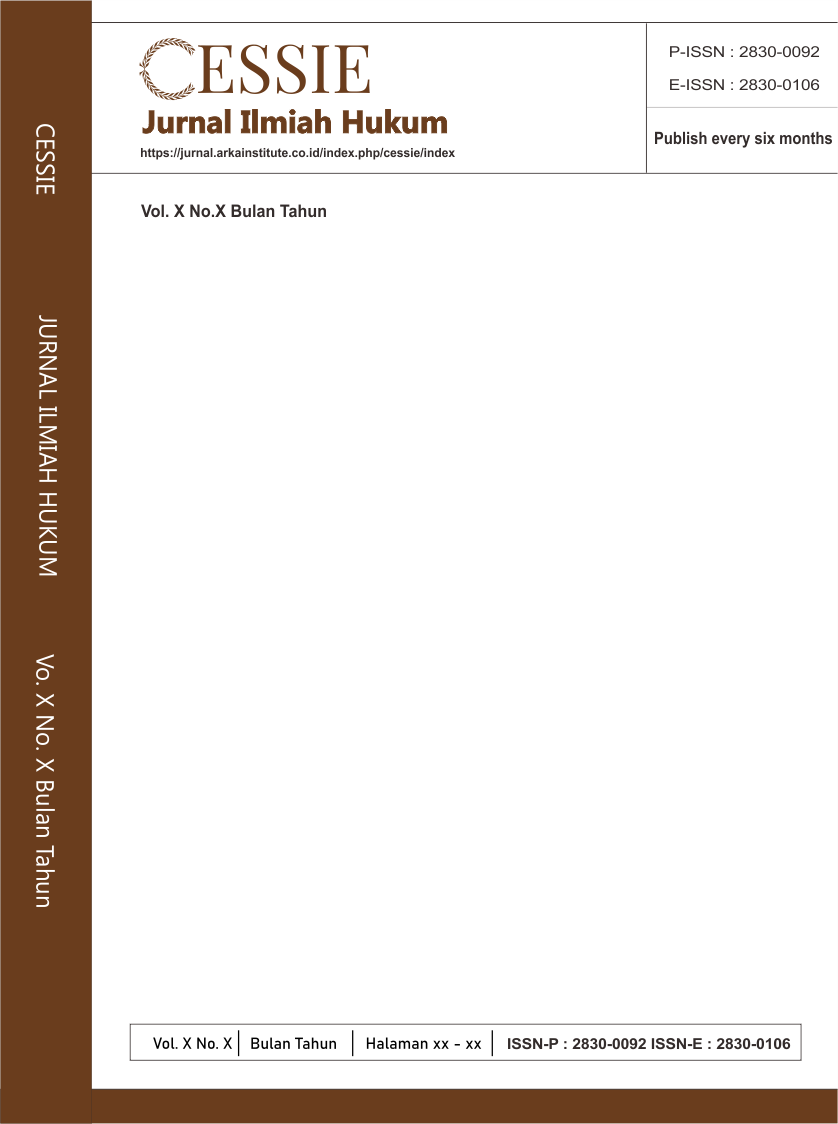Implementation of restorative justice in criminal case settlement to overcome over capacity of correction institutions
Main Article Content
Abstract
This research addresses the use of the restorative justice concept to address issues of overcrowding in correctional facilities. The implementation of coaching inmates and correctional students via an educational, rehabilitation, and reintegration-based correctional system is a responsibility of correctional institutions. However, excessive tamping power might lead to other, more complicated issues, making the coaching development now being implemented suboptimally. A restorative justice strategy is one that may be better suited for addressing the overcrowding in correctional facilities. This research employs a normative juridical methodology. The study's findings demonstrate that Indonesian correctional facilities' overcrowding of inmates may be addressed by using the restorative justice idea. By putting this idea into practice, the usage of criminal penalties in relevant laws and regulations may be reduced, allowing criminals to avoid constantly being placed in community facilities. With a variety of legal analysis techniques, research on restorative justice may still advance, giving scholars a fantastic opportunity to expand on the practice's ideas. In particular, the ability of Indonesian scholars to provide fresh insights on the development of Indonesian law.
Article Details
Section

This work is licensed under a Creative Commons Attribution-NonCommercial 4.0 International License.
How to Cite
References
Abrams, Kathryn, and Hila Keren. “Who’s Afraid of Law and the Emotions (2010).” In Research Handbook on Law and Emotion, 566–600. Edward Elgar Publishing, 2021. https://doi.org/10.4337/9781788119085.00053.
Ahmadi, Cecep Ibnu, Dian Ekawaty Ismail, and Andika W Machmud. “The Politics of Criminal Law in Self-Defense in Indonesia: Regulatory And Enforcement Discourses.” Jurnal Legalitas 16, no. 1 (2023): 1–14. https://doi.org/10.33756/jelta.v16i1.17079.
Anggraeny, Kurnia Dewi, and Petrus Kanasius Kristiaga. “The Relevance of Restorative Justice in Reducing Overcapacity in Correctional Institutions for Male and Female Prisoners.” Kosmik Hukum 25, no. 1 (2025): 160–71.
Cahyadi, Dedy, and Abdullah Sulaiman. “The Role of Legal Reform in Addressing Prison Overcrowding and Strengthening The Guarantee of Inmates’ Human Rights.” Greenation International Journal of Law and Social Sciences 3, no. 2 (2025): 205–12. https://doi.org/10.38035/gijlss.v3i2.414.
Estes, Michelle L, Maggie Leon-Corwin, and Jericho R McElroy. “Unsafe Communities: Environmental Injustice in Carceral Spaces.” Safer Communities 23, no. 2 (2024): 124–41. https://doi.org/10.1108/SC-08-2023-0039.
Hadi, Adwi Mulyana, Anik Iftitah, and Syahrul Alamsyah. “Restorative Justice through Strengthening Community Legal Culture in Indonesia: Challenges and Opportunity.” Mulawarman Law Review 8, no. 1 (2023): 32–44. https://doi.org/10.30872/mulrev.v8i1.1140.
Haggerty, Kevin D, and Sandra M Bucerius. “Picking Battles: Correctional Officers, Rules, and Discretion in Prison.” Criminology 59, no. 1 (2021): 137–57. https://doi.org/10.1111/1745-9125.12263.
Hariyanto, Hariyanto, and Fihtriatus Shalihah. “The Purpose of Crimination against Perpetrators and Victims in the Perspective of Restorative Justice.” Corruptio 4, no. 1 (2023): 1–12. https://doi.org/10.25041/corruptio.v4i1.2922.
Herudiansyah, Roy Rovalino, Pujiyono Pujiyono, and Nur Rochaeti. “The Conception of Restorative Justice in Actualization of the Indonesian Criminal Justice System.” Budapest International Research and Critics Institute-Journal (BIRCI-Journal) 5, no. 3 (2022). https://doi.org/10.33258/birci.v5i3.6649.
Kiyala, Jean Chrysostome K. “Restorative Justice in Theory.” In Child Soldiers and Restorative Justice: Participatory Action Research in the Eastern Democratic Republic of Congo, 179–97. Springer, 2018.
Lin, Tianzhao, Hong Chen, and Jingjing Wu. “Research on the Impact of Restorative Justice Implementation on the Social Reintegration of Offenders and the Reduction of Recidivism Rates.” Law and Economy 2, no. 11 (2023): 25–36.
Marder, Ian Dominic. “Restorative Justice and the Police: Exploring the Institutionalisation of Restorative Justice in Two English Forces.” University of Leeds, 2018.
Marshall, Christopher D. “Restorative Justice.” In Religion Matters: The Contemporary Relevance of Religion, 101–17. Springer, 2020.
Nafid, Youness, Mohamed Ali Haidass, and Sara Joraiche. “The Role of Criminal Alternatives as a Future Challenge in Achieving Security.” International Journal of Criminal Justice Sciences 19, no. 1 (2024): 552–86.
Nasution, Nurul Putri Awaliah, Fathul Hamdani, and Ana Fauzia. “The Concept of Restorative Justice in Handling Crimes in the Criminal Justice System.” European Journal of Law and Political Science 1, no. 5 (2022): 32–41. https://doi.org/10.24018/ejpolitics.2022.1.5.37.
Pieter, Salvadoris, Nurul Widhanita Y Badilla, and Rudini Hasyim Rado. “Criminology Prespectives of Criminal Acts in Correctional Institutions.” In International Joined Conference on Social Science (ICSS 2021), 464–72. Atlantis Press, 2021. https://doi.org/10.2991/assehr.k.211130.084.
Ptacek, James. “Research on Restorative Justice in Cases of Intimate Partner Violence.” Preventing Intimate Partner Violence, 2017, 159–84.
Pudjiastuti, Diah, Dey Ravena, and Chepi Ali Firman Zakaria. “Alternatives to Imprisonment as an Effort to Overcome Overcrowding in Correctional Institutions.” Jurnal Wawasan Yuridika 9, no. 1 (2025): 39–53. https://doi.org/10.25072/jwy.v9i1.4275.
Utomo, Prio Budi Tri, and Yusuf Saefudin. “Implementation of The Concept of Restorative Justice in Overcoming Over Capacity in Correctional Institutions.” Proceedings Series on Social Sciences & Humanities 14 (2023): 400–403. https://doi.org/10.30595/pssh.v14i.1073.
Yunara, Edi, and Taufik Kemas. “The Role of Victimology in the Protection of Crime Victims in Indonesian Criminal Justice System.” Mahadi: Indonesia Journal of Law 3, no. 01 (2024): 63–78. https://doi.org/10.32734/mah.v3i01.15379.

